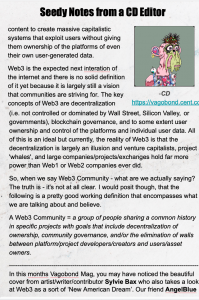This post is the editorial introduction essay by CD from Vagobond Magazine Issue 7 which can be purchased as a readable NFT on Opensea

What is Web3 Community? This month’s issue of Vagobond Magazine is focused on Web3 Community. Before we dive into looking at articles from our contributors – I think it’s really important that we come to a clear understanding of what we’re talking about when we say ‘Web3 Community’.
When we talk about Web3 Community we are not referencing a geographical definition, instead we are more closely talking about what the Oxford Dictionary defines as ‘a feeling of fellowship with others, as a result of sharing common attitudes, interests, and goals’ and also what Merriam-Webster defines as a group of people sharing a common history orhaving a shared ownership interest. For our purposes, I would combine these definitions to something like: a group of people sharing a common history in specific Web3 projects that may also include shared ownership and project specific goals.
The trickier definition is Web3. Web3 is the next (some would say future, some would say present) iteration of electronic data connectivity.
Web1 is the internet of the 1990s and 2000s – a world wide web of interconnected sites and data connected with http://www – that is hypertext transfer protocol world wide web.
Web2 is the mobile, social media, and walled garden internet born with the advent and domination of Facebook, Apple, Google, and other mega-sites that utilized data-mining and user generated content to create massive capitalistic systems that exploit users without giving them ownership of the platforms of even their own user-generated data.
Web3 is the expected next interation of the internet and there is no solid definition of it yet because it is largely still a vision that communities are striving for. The key concepts of Web3 are decentralization i.e. not controlled or dominated by Wall Street, Silicon Valley, or governments), blockchain governance, and to some extent user ownership and control of the platforms and individual user data. All of this is an ideal but currently, the reality of Web3 is that the decentralization is largely an illusion and venture capitalists, project ‘whales’, and large companies/projects/exchanges hold far more power than Web1 or Web2 companies ever did.
So, when we say Web3 Community – what are we actually saying? The truth is – it’s not at all clear. I would posit though, that the following is a pretty good working definition that encompasses what we are talking about and believe.
A Web3 Community = a group of people sharing a common history in specific projects with goals that include decentralization of ownership, community governance, and/or the elimination of walls between platform/project developers/creators and users/asset owners.
——————————————————————————————
 In Issue 7 of Vagobond Mag, you may have noticed the beautiful cover from artist/writer/contributor Sylvie Bax who also takes a look at Web3 as a sort of ‘New American Dream’. Our friend AngelBlue is back with a fresh look at one of the most exciting Web3 music communities around Warpsound. We have a manifesto like essay from the members of PageDAO penned by our friend and collaborator T. Dylan Daniel with input from the entire PageDao community. I also share my very formative first three Web3 Community experiences. First time contributor Quilia dives into DAOs.
In Issue 7 of Vagobond Mag, you may have noticed the beautiful cover from artist/writer/contributor Sylvie Bax who also takes a look at Web3 as a sort of ‘New American Dream’. Our friend AngelBlue is back with a fresh look at one of the most exciting Web3 music communities around Warpsound. We have a manifesto like essay from the members of PageDAO penned by our friend and collaborator T. Dylan Daniel with input from the entire PageDao community. I also share my very formative first three Web3 Community experiences. First time contributor Quilia dives into DAOs.
Decentralized Autonomous Organizations are one of the vehicles being used to create Web3 communities. New contributor Stotteyman shares his experience with and love for his Web3 Community ‘The Crypto Crew’. Another first time contributor to Vagobond Magazine GroupieGoat gives us an inside look at the Peaceful Groupies. My co-host for The Page Dao Show, the always insightful Rionna Morgan shares her journey into Web3 community and some of her favorite community places. E.R. Donaldson looks at the fun experiement of NFT365 and the Web3 community that has grown around it. We have all of this plus the quick hits of a few communities you may want to look at more closely among them SolType, On Chain Monkey, Cult DAO, and of course our own Vagobond Discord. In addition, as usual I share my chip lists of projects I enjoy and how I rank them, my (mostly worthless) NFT acquisitions from the previous month, and of course a look at Bald Jesus and Bald Jesusism and some important metaverse holidays in October. Chapter 6 of Sly Doubt wraps up this issue as the Uranus serial series starts to pick up speed. Next month: What do you get when you combine PFPs with creative writing? I guess we’ll see. Enjoy this great issue – possibly our best yet. – CD






